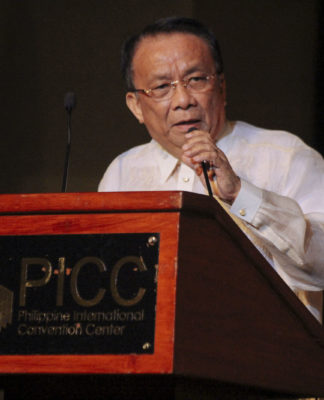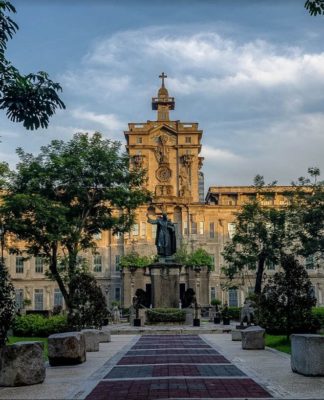THE NINETIES were characterized by rapid advances in technology that influenced the conduct of journalism. The Varsitarian was not immune from these changes. It became a technology-driven newsroom.
Early in the decade, Varsitarian writers typed their articles using old Olympia typewriters, while photographers used manual Canon cameras and Meopta printing equipment.
“Iyon ang nami-miss ko—the sound of a busy newsroom. When you hear the people typing, ang sarap magtrabaho,” said Ramil Gulle, Varsitarian associate editor from 1995 to 1996. “To me, the sound was as beautiful as those stories being written.”
The work of the staff was harder then. Stories were written using outmoded equipment, then transferred to a huge “dummy” using manual cut-and-paste techniques. The publication acquired computers only in 1995. This not only restructured the office, it also changed the work process as well. Information technology (IT) changed the way the paper did its job.
The refurbishment of the Varsitarian office included construction of wood and glass divisions and an upper floor, which has since served as the newsroom and archive.
“We still bought new typewriters although we had one computer. Wala pang Windows, DOS pa lang,” Gulle recalled. “The only word processing program was WordPerfect or WordStar.”
Since then, the Varsitarian office has become arguably the most IT-advanced newsroom in the Philippine campus press. It now has several computers. It uses Windows 98 as operating system. It uses Adobe Photoshop for pagemaking and imaging. All of these programs are licensed, which means the paper had to allocate a large chunk of its funds to comply with intellectual property rights. It also has its own facsimile transmission machine and scanner.
The Varsitarian is also Internet-connected. This is both a boon and a bane – a bane really if you go by the irritation of the publications adviser who complains about the penchant of some staffers to play noisy network games and to access sexy websites.
Decade of firsts
The latter part of the 90s proved to be a breakthrough. Important events and several firsts were conceived and implemented.
In 1998, the paper reformatted and came up with an updated, more reader-friendly look. Before that, the staff under Christian Esguerra, the editor in chief formulated the paper’s vision-mission, stressing the paper’s identity as a community paper of a Catholic and Dominican institution.
“Mas nag-mature iyong diyaryo in terms of approach and style. Mas naging maingat kami,” Esguerra said.
To mark its 70th anniversary, the Varsitarian held a grand alumni homecoming that saw the gathering of many of the paper’s most prominent alumni. Lending nostalgia to the event, the homecoming was held at the UST Main Building lobby, the first time a party was conceived and held there. The program was raucous and lively as it was emceed by comedian Bernardo Bernardo (yes, he was Varsitarian editor in chief in the late 1960s), singer-writer Googoo de Jesus, and academic-writer Jose Wendell Capili.
Prior to the homecoming, the Varsitarian held interactive exhibits, an outreach program and a poetry reading session.
In 1999 during Esguerra’s second term, Inkblots, the nationwide campus journalism fellowship, was born. Inkblots, a brainchild of publications adviser Joselito Zulueta, was surprisingly conceptualized during one of the staff’s casual dinners.
Now on its fourth year, Inkblots has proved to be one of the significant developments of the Varsitarian in the ‘90s, helping student writers all over the country hone their journalistic skills and boosting the staff’s competence in organizing a major event.
Christmas inspiration
Coming out with a Christmas issue was the hardest for the staff. Most writers had to postpone going home to their respective provinces for the Christmas break just to wrap up the Christmas edition. The artists, who played pivotal roles in the Christmas issue, were burdened with academic work.
In the Christmas issue, the usually screaming headlines of the front page were relocated to page two. Instead, colorful photographs or art works made up the cover of the December issue.
“We had a photo essay for the centerfold,” remembered Gulle. “May mga columns pa rin and opinions. Above all, iyon talaga iyong time for the Witness section to shine.”
Now as then, the Christmas issue is also highlighted by a handful of Christmas stories, personal essays, and literary contributions.
Gulle said that the Christmas season had a positive effect on the whole staff. The individual spirituality of each staffer was expressed through write-ups, photographs, and art works published in the Christmas edition. It was the Varsitarian’s inspirational issue.
The Christmas issue played the role of a peacemaker. “Kahit marami sa staffers ang magkaaway the entire year, kapag ginagawa na ang Christmas issue, nagbabati na,” Gulle said.
He also emphasized the exceptional bonding of the whole Varsitarian staff. He described the staff as a close-knit group. Everyone felt like celebrating Christmas with two families, instead of one, Gulle said.
The intimacy was attributed to the hard work, the time spent together, and the challenge brought about by coming out with a Christmas edition.
Gulle admitted that the selling point of this particular issue was its colored illustration, which was patterned from the colored covers of the Varsitarian magazines of the 60s.
The whole staff, according to Gulle, would put much energy and effort on the Christmas issue’s cover. And the product was remarkable art.
Gulle said of his favorite Christmas art work: “Instead of making you feel depressed, you see the beauty and you see hope.”
For the Varsitarian staffers in the ‘90s, the advent of Christmas was not a mere foreboding of the tedious preparation for the Christmas issue. It was a brilliant testimony to the staff’s transcendental and binding family spirit.















